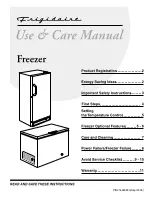
3-18
Refrigeration System
Combustibility of HFC-134a
HFC-134a is nonflammable at ambient
temperatures and atmospheric pressure. However, tests
have shown HFC-134a to be combustible at pressures
as low as 5.5 psig (139.3 kPa absolute) at 177°C
(350°F) when mixed with air at concentrations generally
greater than 60% volume air. At lower temperatures,
higher pressures are required for combustibility.
(HCFC-22 is also combustible at pressures above
atmospheric in the presence of high air concentrations).
Test results and calculations have shown:
•
At ambient temperature, all concentrations of
HFC-134a in air are nonflammable at pressures
below 15 psig (205 kPa absolute).
•
Combustible mixtures of air and HFC-134a will not
form when liquid HFC-134a is pumped into closed
vessel if initial air pressure in vessel is limited to one
atmosphere absolute and final pressure is limited to
300 psig (2,170 kPa absolute). If initial air pressure
is greater than one atmosphere, combustible
mixtures may form as tank is filled.
Based on above information, the following
operating practices are recommended:
Leak Testing
•
Equipment should NEVER be leak tested with a
pressurized mixture of HFC-134a and air. HFC-134a
may be safely pressured with dry nitrogen.
Bulk Delivery and Storage
•
Tanks should normally be evacuated at start of
filling, and should never be filled while under
positive air pressure.
•
Tank pressure should never be allowed to exceed
300 psig (2,170 kPa) when filling with HFC-134a.
Relief devices on either tanks or HFC-134a supply
system usually prevent this.
•
Tank pressures should be monitored routinely.
•
Air lines should never be connected to storage
tanks.
Filling and Charging Operations
•
Before evacuating cylinders or refrigeration
equipment, any remaining refrigerant should be
removed by recovery system.
•
Vacuum pump discharge lines should be free of
restrictions that could increase discharge pressures
above 15 psig (205 kPa) and result in formation of
combustible mixtures.
•
Cylinders or refrigeration equipment should
normally be evacuated at start of filling, and should
never be filled while under positive air pressure.
•
Final pressures should not exceed 300 psig
(2,170 kPa).
•
Filled cylinders should periodically be analyzed
for air (nonabsorbable gas or NAG).
Refrigerant Recovery Systems
Efficient recovery of refrigerant from equipment or
containers requires evacuation at the end of the
recovery cycle. Suction lines to a recovery compressor
should be periodically checked for leaks to prevent
compressing air into the recovery cylinder during
evacuation. In addition, the recovery cylinder pressure
should be monitored, and evacuation stopped in the
event of a rapid pressure rise indicating the presence of
noncondensable air. The recovery cylinder contents
should then be analyzed for NAG, and the recovery
system leak checked if air is present. DO NOT
continue to evacuate a refrigeration system that has a
major leak.
Thermal Decomposition
HFC-134a vapors will decompose when exposed to
high temperatures from flames or electric resistance
heaters. Decomposition may produce toxic and
irritating compounds, such as hydrogen fluoride. The
pungent odors released will irritate the nose and throat
and generally force people to evacuate the area.
Therefore, it is important to prevent decomposition by
avoiding exposure to high temperatures.
Содержание FKCH17F7HW
Страница 2: ......
Страница 3: ...Basic Information 1 1 Section 1 Basic Information ...
Страница 9: ...Electronic Control 2 1 Section 2 Electronic Control ...
Страница 14: ...2 6 Electronic Control Notes ...
Страница 15: ...3 1 Refrigeration System Section 3 Refrigeration System ...
Страница 30: ...3 16 Refrigeration System HFC 134a CFC 12 Pressure Temperature Chart ...
Страница 33: ...4 1 Component Teardown Section 4 Component Teardown ...
Страница 47: ...5 1 Troubleshooting Section 5 Troubleshooting ...
Страница 52: ...5 6 Troubleshooting Notes ...
Страница 53: ...6 1 Wiring Diagrams Section 6 Wiring Diagrams ...
Страница 54: ...6 2 Wiring Diagrams 7 4 6 2 8 3 5 1 ...
Страница 56: ...7 1 Section 7 Installation Information Installation Information ...
Страница 62: ...7 7 Installation Information Model FKCH17F7HW Unit Dimensions ...
Страница 63: ...7 8 Installation Information Notes ...
















































